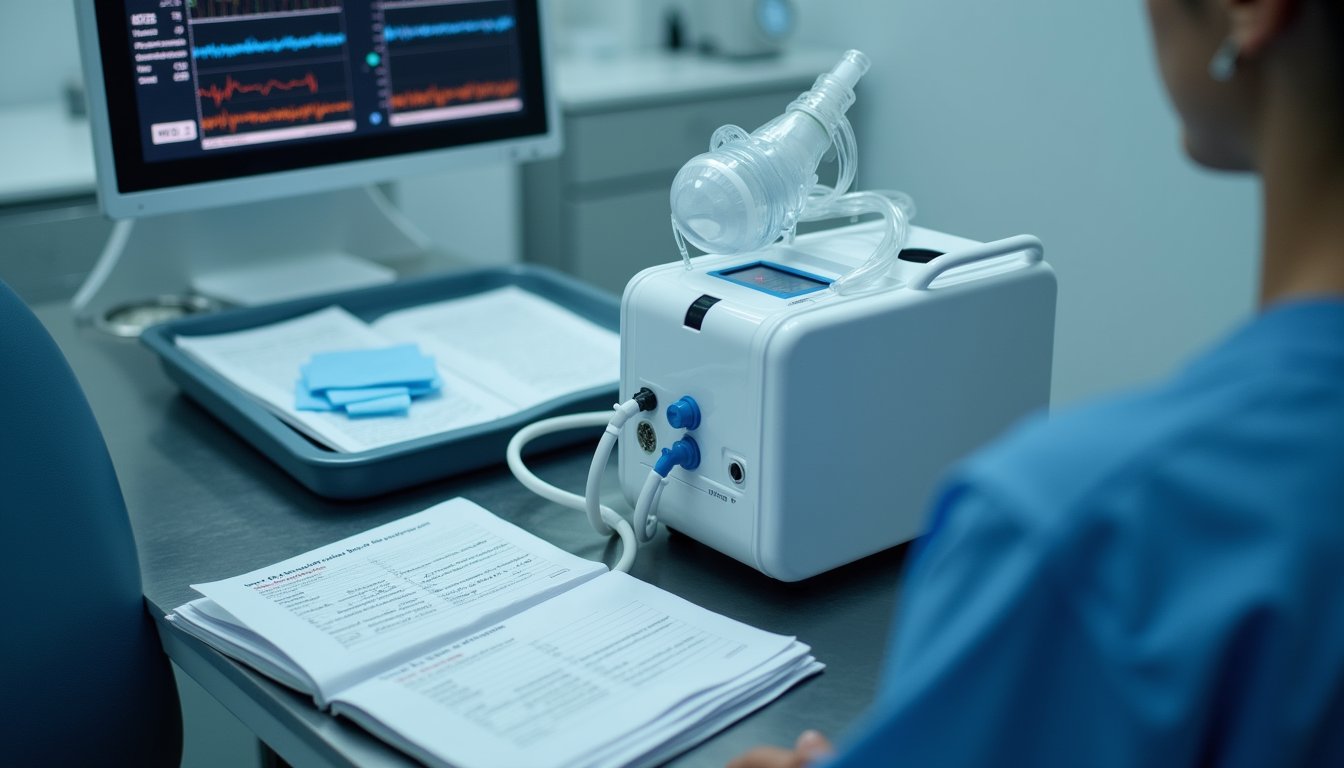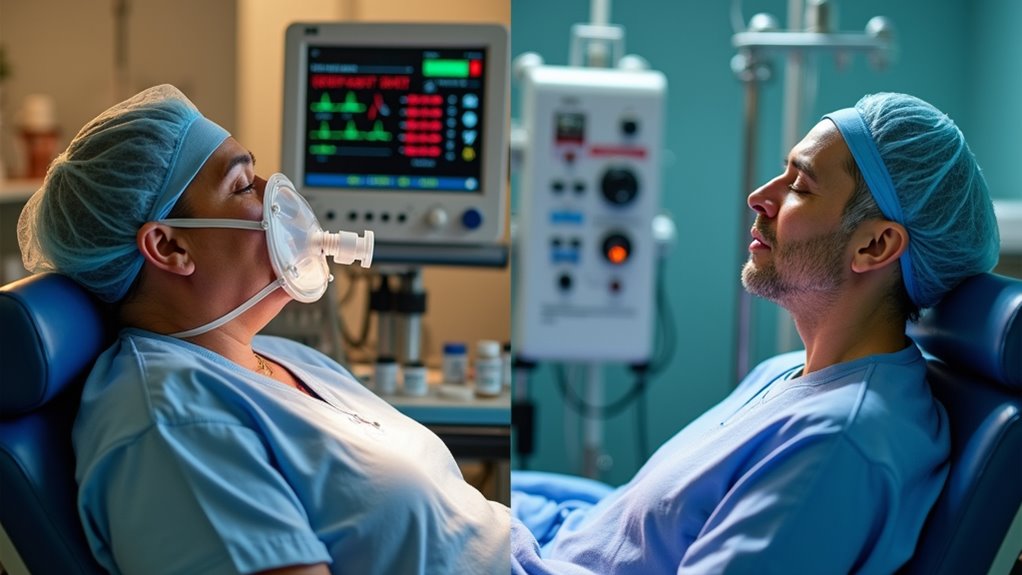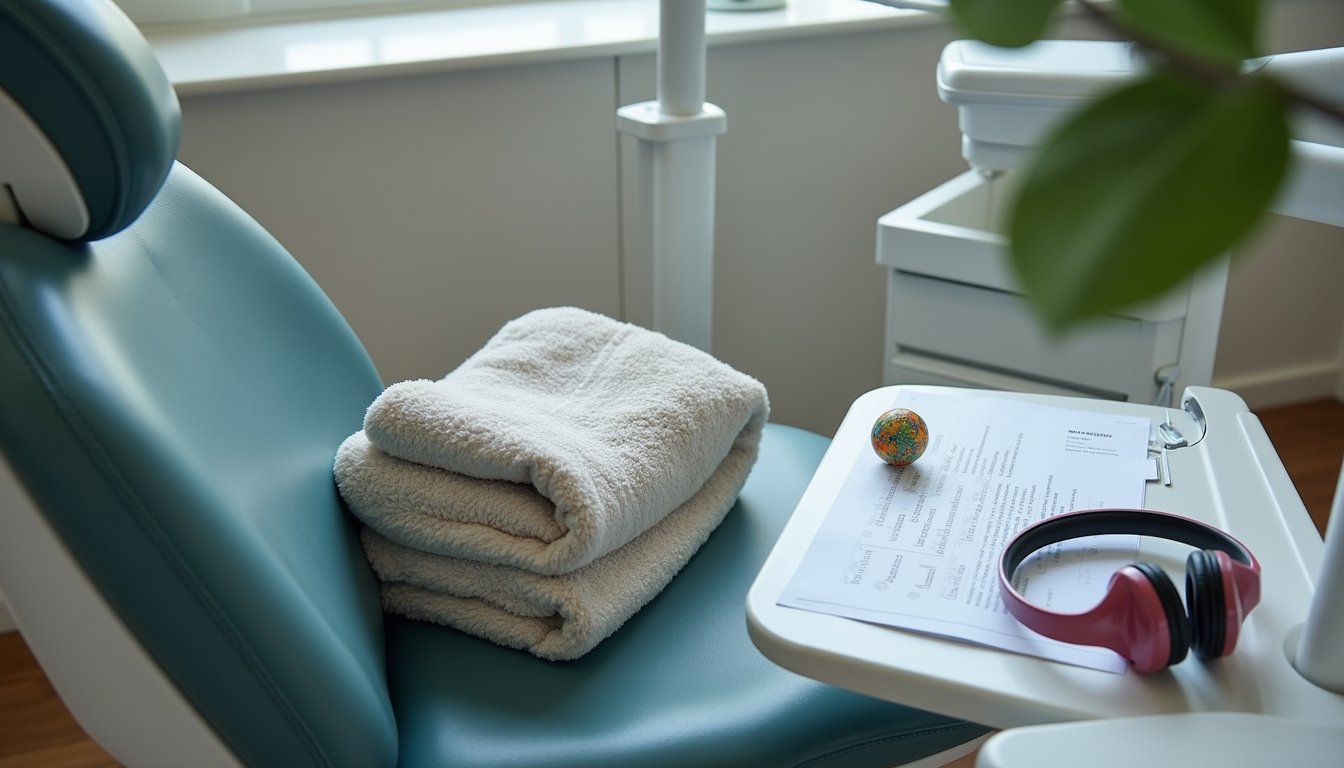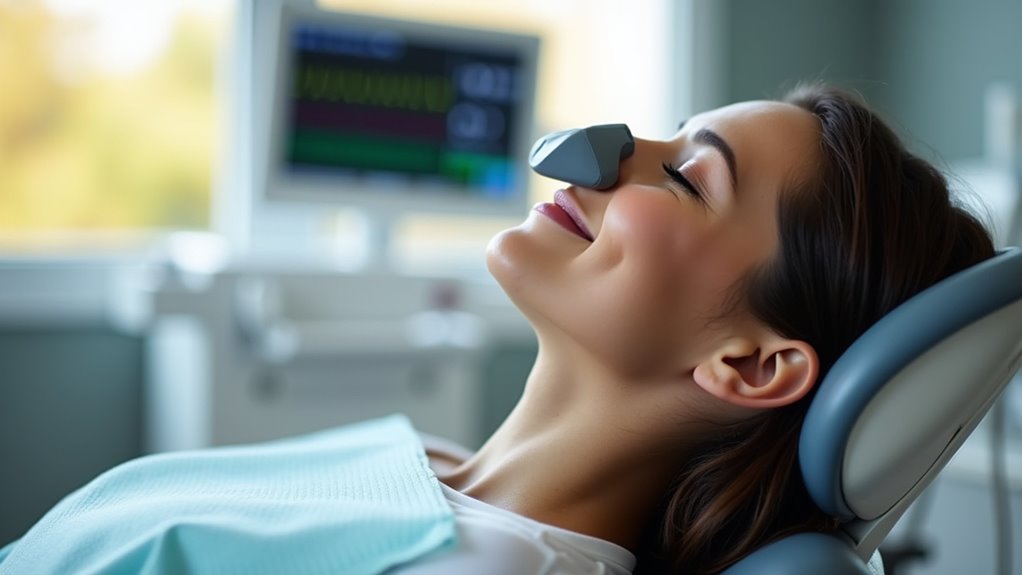Nitrous oxide’s dual-action mechanism delivers superior patient wellness through its rapid onset and precise control. You’ll experience anxiety relief and pain reduction while maintaining consciousness and protective reflexes. Unlike traditional sedatives, N₂O allows immediate recovery without lingering drowsiness or monitoring requirements. Your body efficiently eliminates the gas through normal breathing, minimizing side effects and complications. This unique pharmacological profile represents just the beginning of nitrous oxide’s advantages in modern sedation protocols.
The Science Behind Nitrous Oxide’s Dual-Action Mechanism

Understanding nitrous oxide’s mechanism reveals a sophisticated interplay between multiple neural pathways. You’ll find its primary actions occur through NMDA receptor inhibition and opioid pathway activation, delivering both rapid anxiolysis and targeted analgesia.
When you receive nitrous oxide, it binds to μ-opioid receptors while simultaneously blocking glutamate-mediated pain signals. This dual-action approach boosts GABA activity, promoting relaxation without excessive sedation. You’ll maintain cognitive function while experiencing pain relief through endorphin release and natural analgesic mechanisms. The gas’s unique properties allow it to be rapidly eliminated from the body through normal breathing. Its sweet taste and scent makes it more pleasant for patients compared to other sedatives.
What sets nitrous oxide apart is its balanced neurotransmitter modulation. You’ll benefit from precise control over sedation levels through titrated delivery, while avoiding the deep sedation and recovery periods associated with other anxiolytics. The result is comprehensive comfort with preserved consciousness. Its rapid onset of action allows dentists to quickly achieve the desired level of sedation for optimal patient comfort.
Quick Recovery: A Game-Changer in Modern Sedation
When compared to traditional sedation methods, nitrous oxide’s rapid recovery profile stands as a defining advancement in modern clinical practice. You’ll experience effects within minutes of administration, yet recover swiftly once the gas is discontinued, enabling a seamless return back to normal activities. Patients report feeling comfortable and relaxed during their dental procedures. The technique’s two-way titrability allows precise control over sedation levels throughout the procedure.
Unlike midazolam or ketamine, nitrous oxide eliminates extended post-procedure monitoring requirements. The efficient workflow allows clinicians to schedule consecutive procedures without prolonged recovery periods. You’ll find this particularly beneficial as you won’t need extended recovery room time or lengthy supervision. This streamlined approach has proven especially valuable in streamlining hospital procedures for pediatric patients.
The predictable offset dynamics of nitrous oxide, combined with its compatibility across diverse patient populations, revolutionizes sedation protocols. This rapid recovery characteristic supports multidisciplinary applications while maintaining high safety standards and patient satisfaction in clinical environments.
Comparing Safety Profiles: Nitrous Vs Traditional Sedatives

While traditional sedatives often require extensive cardiorespiratory monitoring and IV access, nitrous oxide’s safety profile allows for simplified physiological oversight through basic critical sign checks and continuous oxygen saturation monitoring. Based on systematic reviews, safety data remains limited for nitrous oxide and other sedation methods in dental settings. Unlike oral sedation which requires patients to take medication an hour beforehand, nitrous oxide takes effect quickly through mask administration. The gas is administered through a nose-piece or mask for controlled and efficient delivery during dental procedures. You’ll find that nitrous oxide demonstrates markedly lower risks of adverse events, with minimal cardiorespiratory depression and preservation of protective airway reflexes compared to IV or oral sedatives. Your recovery from nitrous sedation occurs within minutes of discontinuation, unlike traditional sedatives that can leave you impaired for hours due to metabolic processing and adipose tissue accumulation.
Physiological Monitoring Requirements
Although traditional sedatives often require extensive physiological monitoring, nitrous oxide demonstrates a markedly simplified monitoring protocol due to its superior safety profile. You’ll find that pulse oximetry provides sufficient continuous monitoring of oxygen saturation, eliminating the need for invasive measures like ECG or blood pressure tracking. Your dental auxiliary staff must complete a six-hour N₂O-O₂ monitoring course and maintain periodic recertification to guarantee proficiency.
The monitoring process integrates basic life support certification with specialized training in pain management and sedation philosophy. Your facility’s scavenging systems and air quality sensors protect staff while maintaining ideal gas flow. This streamlined approach, combined with N₂O’s minimal impact on consciousness and respiratory function, delivers effective anxiolysis without the complex monitoring demands of traditional sedatives.
Risk of Adverse Events
Compared to traditional sedatives, nitrous oxide demonstrates a superior safety profile through multiple physiological mechanisms. You’ll experience reduced overdose risk due to its lower MAC value of 104, while maintaining preserved airway reflexes that protect your breathing function. The drug’s rapid absorption and clearance through the inhaled route prevents systemic accumulation and minimizes long-term toxicity concerns. Multiple randomized trials have validated the efficacy and safety of nitrous oxide sedation specifically for dental extractions in children.
The absence of significant drug interactions and initial pass metabolism makes nitrous oxide exceptionally safe when combined with other medications. Unlike deeper sedatives, you’ll maintain verbal responsiveness and protective reflexes throughout the procedure. The most common side effect is mild nausea, which resolves quickly through hydration. With no dependency potential and reversible CNS effects, you can safely undergo repeated procedures without developing tolerance or requiring extensive monitoring. Since the gas is easily adjustable by your dentist during treatment, the ideal sedation level can be maintained throughout your procedure. The quick recovery time allows patients to resume normal activities immediately after their dental visit.
Recovery Time Differences
The rapid recovery profile of nitrous oxide sets it apart from traditional sedative agents in clinical settings. You’ll experience improved psychomotor performance within minutes of discontinuation, compared to the prolonged effects of alternatives like midazolam, which can extend recovery times up to 80 minutes. With a median recovery time of 40 minutes, nitrous oxide consistently demonstrates superior efficiency in patient discharge protocols.
Upon cessation of nitrous oxide administration, rapid homeostatic normalization occurs, with oxygen saturation and pulse rates returning to baseline values. The data shows that only 5.9% reported headaches, providing strong evidence of minimal post-procedure complications. You won’t require an escort post-procedure, and you can resume normal activities immediately. This accelerated recovery eliminates the need for extended monitoring protocols or complex post-procedure care. The absence of residual sedation and drowsiness further distinguishes nitrous oxide from traditional sedatives, enabling a more efficient clinical workflow while maintaining ideal patient safety margins during dose adjustments.
Patient Comfort Through Non-Invasive Administration

Non-invasive administration of nitrous oxide represents a cornerstone of patient comfort in modern dental practices. The delivery system optimizes patient satisfaction through a soft, adjustable nasal mask that guarantees precise control of gas mixtures while minimizing discomfort. You’ll maintain full consciousness and communication abilities throughout your procedure, allowing real-time feedback to your dentist. Dental phobia patients particularly benefit from this stress-free approach to sedation.
- Incremental dosing allows seamless adjustment of concentration levels based on your individual needs
- Real-time monitoring combines oxygen-enriched delivery with continuous assessment to prevent over-sedation
- Your natural reflexes remain intact while you experience immediate sedation effects
The system’s controlled administration mechanisms ensure you’ll experience no systemic side effects or residual drowsiness. This approach eliminates the need for recovery periods, enabling you to resume normal activities immediately after your procedure.
Cost-Effective Benefits for Dental Practices
Your dental practice can realize significant cost advantages through nitrous oxide’s streamlined staff certification requirements and simplified equipment protocols compared to other sedation methods. The maintenance costs remain minimal due to the system’s durable components and straightforward upkeep procedures, eliminating the need for complex servicing schedules. By enabling faster patient turnover and reducing appointment cancellations, nitrous oxide sedation creates opportunities for increased daily patient volume while maintaining high-quality care standards.
Reduced Staff Training Needs
While many sedation methods require extensive training and certification, nitrous oxide administration stands out for its streamlined training requirements and cost-effective implementation in dental practices. You’ll find that team empowerment begins with just 14 hours of training, and simplified competency checks focus on standardized N2O/oxygen protocols rather than complex pharmacology.
- Your staff can master fixed N2O-to-oxygen ratios and monitoring guidelines quickly, enabling efficient patient care
- Your assistants and hygienists can administer N2O under supervision, maximizing practice capacity
- Your team won’t need advanced airway management or IV sedation certifications, reducing training costs
The minimal adverse reaction profile and predictable patient responses further streamline training needs, while ADA-approved guidelines provide a clear framework for maintaining compliance and safety standards.
Equipment Maintenance Savings
Dental practices implementing nitrous oxide systems benefit from significant equipment maintenance savings compared to other sedation methods. You’ll find that portable N2O units require minimal infrastructure investment while delivering exceptional durability and reliability through simple maintenance protocols.
Daily tasks like handpiece flushing and lubricating components extend your durable equipment lifespan, while weekly O-ring inspections prevent costly gas leaks. The streamlined maintenance schedule helps minimize downtime costs through preventive care rather than reactive repairs. Your monthly cleaning of rubber components and plaster traps protects system integrity, while annual calibrations guarantee consistent performance.
Higher Patient Volume Potential
Beyond equipment savings, nitrous oxide sedation greatly improves practice efficiency through increased patient throughput. With a median procedure duration of just 31 minutes and minimal recovery time needed, you’ll optimize chair utilization while maintaining high-quality care standards. The rapid onset and predictable outcomes enable you to schedule more patients with confidence.
- Quick patient turnover allows multiple treatments within single visits, maximizing your daily appointment capacity
- Same-day procedure capability strengthens scheduling flexibility and reduces unused chair time
- Standardized protocols with fixed gas concentrations (30-50%) guarantee consistent treatment durations for reliable scheduling
Your practice benefits from nitrous oxide’s efficiency, as patients require no extended recovery periods and can be discharged immediately. This immediate recovery profile, combined with low complication rates, supports higher patient volumes while maintaining safety standards.
Expanding Access to Anxiety-Free Dental Care
A transformative shift in modern dentistry has emerged through the widespread implementation of nitrous oxide sedation, enabling practitioners to deliver anxiety-free care to previously underserved populations. You’ll find this versatile sedation method effectively addressing dental phobia across diverse patient groups, with success rates exceeding 93% in both adults and children.
Environmental and Long-Term Health Considerations
While nitrous oxide sedation offers valuable benefits for patient care, its environmental impact presents significant challenges for healthcare sustainability. The NHS’s commitment to net-zero emissions by 2040 requires careful consideration of dental services’ carbon footprint, particularly regarding N2O use. Environmental policy implications extend beyond immediate clinical settings, as N2O has a global warming potential 298 times that of CO2. Long term sustainability targets must balance essential patient care with ecological responsibility.
- N2O emissions from dental procedures contribute approximately 3% of the NHS’s total carbon footprint
- Single-use equipment and gas leakage compound the environmental impact, equivalent to driving 1,366 km
- Healthcare providers must implement sustainability strategies while maintaining clinical efficacy and patient safety standards
Training Requirements and Professional Implementation
Professional mastery of nitrous oxide administration requires thorough training protocols and standardized certification processes. You’ll need to complete a 25-hour certification program that includes clinical case experience and hands-on training in administration techniques. The curriculum emphasizes team coordination through intensive two-day programs combining N₂O with oral sedatives.
Staff competency focuses on equipment handling, patient monitoring, and emergency preparedness. You’ll master gas-to-oxygen ratio control, airway management, and hypoxia recognition. Training covers ADA-recommended protocols, state-specific compliance requirements, and proper documentation standards. You’ll learn advanced titration strategies and crisis intervention techniques through simulation drills. The extensive pharmacological education includes neurotransmitter mechanisms, drug interactions, and contraindications, ensuring you’re prepared for diverse clinical scenarios.
Frequently Asked Questions
Can I Eat or Drink Before Receiving Nitrous Oxide Sedation?
You can eat and drink normally before receiving nitrous oxide sedation, as food intake requirements are minimal compared to other sedation administration procedures. While it’s recommended to have a light meal 2-3 hours before treatment to prevent potential nausea, there’s no mandatory fasting period. You should avoid heavy, greasy foods close to your appointment time and communicate any digestive concerns to your provider before the procedure.
How Long Should I Wait Before Driving After Nitrous Oxide Treatment?
You should wait 15-30 minutes after your nitrous oxide treatment before driving. While the gas clears from your system within 5-10 minutes, this supplementary buffer guarantees you’re fully alert. Monitor yourself for potential side effects like dizziness, nausea, or disorientation. If you experience any of these symptoms, don’t drive immediately. Follow your dentist’s specific guidance, as individual recovery times may vary based on factors like maturity, health conditions, and dosage received.
Will My Dental Insurance Cover Nitrous Oxide Sedation Costs?
Most dental insurance plans won’t cover nitrous oxide sedation, as it’s typically considered an elective service. You’ll likely need to pay out-of-pocket, with costs ranging from $70-$300 per session. However, your plan may cover it if you can prove medical necessity through proper documentation from your dentist. To understand your specific coverage, you’ll need to review your policy details or contact your insurance provider directly for treatment cost effectiveness analysis.
Does Nitrous Oxide Interact With Prescription Medications I’m Currently Taking?
While nitrous oxide has minimal potential drug interactions compared to other sedatives, you’ll need to inform your dentist about all medications you’re taking. The rapid clearance and localized administration of nitrous oxide typically don’t require prescription dosage adjustments. However, if you’re taking anticoagulants, blood pressure medications, or erectile dysfunction drugs, your dentist should evaluate these specifically. Always discuss your complete medication profile during your pre-procedure consultation for personalized guidance.
Can I Request Nitrous Oxide for Routine Dental Cleanings?
You can request nitrous oxide for routine dental cleanings, as it’s an approved method for patient comfort during any dental procedure. Your dentist will evaluate your specific needs and anxiety levels to determine if it’s appropriate. Since nitrous oxide provides quick-acting dental procedure relaxation with minimal recovery time, it’s particularly suitable for routine cleanings. You’ll remain conscious and responsive while experiencing reduced anxiety throughout the appointment.
















